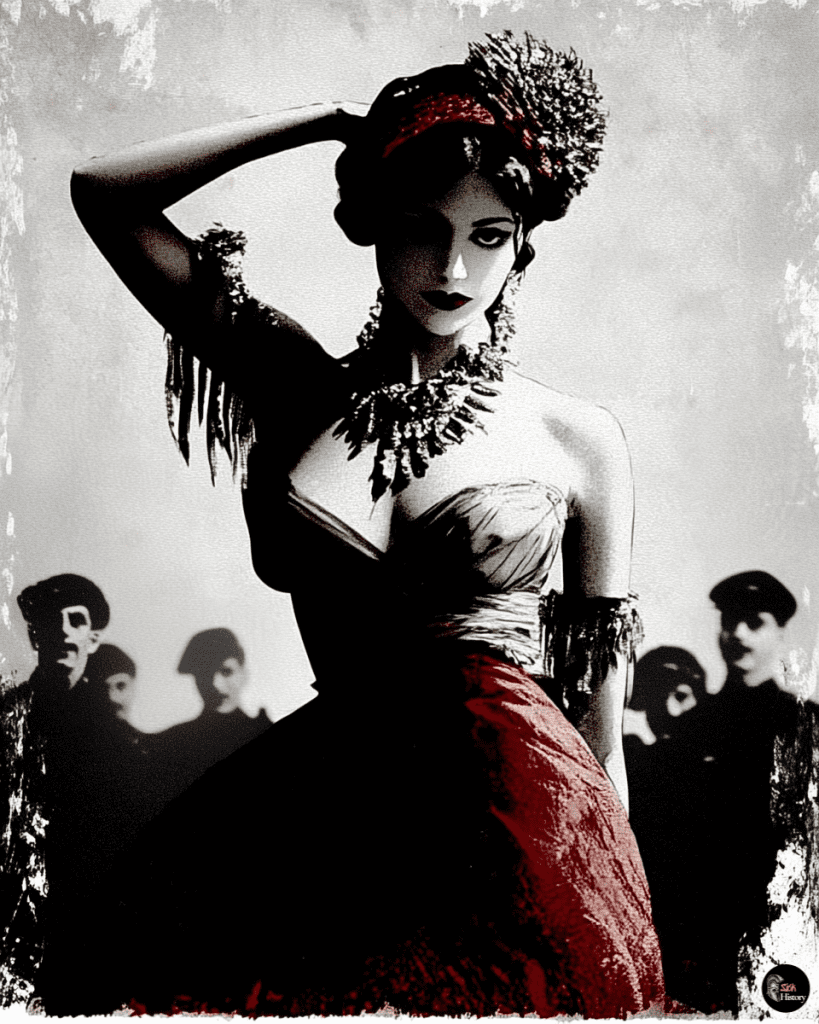Mata Hari, the enigmatic Dutch-born dancer turned spy, captivated Europe with her exotic performances and mysterious allure.
Born Margaretha Geertruida Zelle in 1876, she rose to fame in Paris under her stage name, which means “eye of the day” in Indonesian. Her life, filled with intrigue and controversy, became synonymous with the archetype of the seductive female spy during World War I.
Mata Hari’s journey from exotic dancer to accused double agent is a tale that continues to fascinate historians and the public alike.
As Europe plunged into the chaos of World War I, she found herself entangled in a web of espionage, working for French intelligence while allegedly passing information to the Germans.
Her story challenges gender stereotypes of the era and raises questions about the role of women in wartime intrigue.
The execution of Mata Hari by firing squad in 1917 marked a dramatic end to her controversial life.
Convicted of spying for Germany, her trial and subsequent execution remain subjects of debate, with some arguing she was a victim in a time of heightened paranoia.
Her legacy as a femme fatale and spy continues to inspire books, films, and discussions about the nature of espionage and the power of perception in shaping historical narratives.
The Life and Legend of Mata Hari
Mata Hari’s extraordinary journey from a small Dutch town to the heights of Parisian society and her ultimate downfall as an accused spy captivated the world. Her story blends exoticism, intrigue, and tragedy.
Dutch-Born Dancer
Margaretha Geertruida Zelle was born on August 7, 1876, in Leeuwarden, Netherlands. Her early life was marked by tragedy and a desire for adventure.
After a failed marriage in the Dutch East Indies, she reinvented herself in Paris.
Zelle adopted the stage name Mata Hari, meaning “eye of the day” in Indonesian. This exotic persona allowed her to escape her past and forge a new identity.
Her transformation from a small-town girl to an international sensation was remarkable.
She crafted an elaborate backstory, claiming to be a Javanese princess trained in sacred Indian dances. This fictitious history added to her allure and mystique.
Exotic Dancer
Mata Hari’s performances took Paris by storm in the early 1900s. Her exotic dances and revealing costumes scandalized and thrilled audiences in equal measure. She became one of the most sought-after performers in Europe.
Her act blended sensuality with a hint of the mystical East. Mata Hari’s dances were more about artful nudity than traditional technique. She captivated audiences with her confidence and charisma.
Her fame spread rapidly, and she performed in major European capitals. Mata Hari’s success allowed her to mix in high society circles, forming relationships with powerful men.
Femme Fatale
Mata Hari’s reputation as a femme fatale grew alongside her fame. She became known as a courtesan, entertaining wealthy and influential men. Her liaisons spanned the elite of European society, including military officers and politicians.
As World War I erupted, Mata Hari’s international connections drew suspicion. Her travels between warring nations raised eyebrows.
Espionage and Execution
Mata Hari’s involvement in World War I espionage led to her dramatic downfall. Her story intertwines elements of intrigue, deception, and the harsh realities of wartime intelligence.
World War I Espionage
During World War I, espionage became a crucial aspect of military strategy. Mata Hari, with her international connections and charm, found herself in a prime position to gather intelligence.
Her exotic dancer persona allowed her to move freely between countries and interact with high-ranking officials.
Mata Hari’s activities included gathering information on troop movements and military plans. She used her relationships with military officers to gain access to sensitive information. Her methods were unconventional but effective, relying on her charisma and seductive skills.
Double Agent
Mata Hari’s role as a double agent remains a subject of debate. She allegedly worked for both French and German intelligence services.
This dual allegiance made her a valuable asset but also heightened suspicions about her loyalty.
Her motivations for espionage were complex. Financial gain played a role, but so did her desire for adventure and recognition.
Mata Hari’s ability to navigate between opposing sides demonstrated her cunning and adaptability.
French Intelligence
French intelligence services closely monitored Mata Hari’s activities. They became increasingly suspicious of her frequent travels and high-profile relationships. The French believed she was passing valuable information to the Germans.
In 1916, French intelligence intercepted messages that implicated Mata Hari as a German spy. This evidence led to her arrest in Paris in February 1917. The French authorities accused her of providing critical military information to the enemy.
German Spy
The extent of Mata Hari’s involvement with German intelligence remains uncertain. Some historians argue that she provided minimal useful information to the Germans. Others contend that she was a skilled operative who caused significant damage to Allied interests.
German records from the period are incomplete, making it difficult to verify her exact role. Some evidence suggests that Mata Hari may have been more of a scapegoat than a genuine threat to Allied security.
Executed Spy
Mata Hari’s trial in July 1917 was brief and controversial. The evidence against her was largely circumstantial, but the wartime atmosphere favored harsh treatment of suspected spies.
She was found guilty of espionage and sentenced to death.
On October 15, 1917, Mata Hari was executed by firing squad at Vincennes near Paris. She faced her death with remarkable composure, refusing a blindfold and blowing a kiss to the firing squad.
Her execution became a symbol of the ruthlessness of wartime justice and the dangers faced by those caught in the world of espionage.

